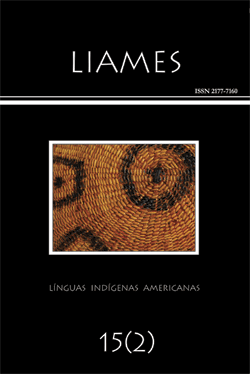Resumo
The caracterization of nominalized constructions has been richly discussed in the linguistic literature. The discussion of this morpho-syntactic phenomenon considers not only its role in the formation of new words, but also on their syntactic function. This paper compares nominalized constructions in two extinct Uto-Aztecan languages spoken in northwestern Mexico. The aim of this paper is to show the mixed character of such constructions and to demonstrate that among the main properties of these syntactic constructions we can find genitive subjects, case marking of the clause and embedded clauses within the limits of the main construction.
Referências
Álvarez González, Albert (2012). Relative clauses and nominalizations in Yaqui. En Bernard Comrie; Zarina Estrada-Fernández (eds.). Relative clauses in Languages of the Americas: A typological overview, pp. 67-95. Amsterdam: John Benjamins.
Bandelier, Adolph F.A. (1890-1892). Final report of investigations among the indians of the Southwestern United States. Carried on mainly in the years from 1880-1885. 2 vols. Papers of the Archeological Institute of America. American Series 3 and 4. Cambridge, Mass
Bisang. Walter (2001). 100. Finite vs non-finite languages. En Martin Haspelmath; Ekkehard König; Wulf Oesterreicher; Wolfgang Raible (eds.). Language Typology and Language Universals. An International Handbook, vol. 2, pp. 1400-1430. Berlin-New York: Walter de Gruyter.
Comrie, Bernard; Thompson, Sandra A. (2007) [1985]. Lexical nominalization. En Timothy Shopen (ed.). Language typology and syntactic description III: Grammatical categories and lexicon, pp. 334-381. Cambridge: Cambridge University Press.
Dunnigan, T. (1983). Lower Pima. En Alfonso Ortiz (ed.). Handbook of North American Indians, Southwest, vol. 10, pp. 217-229. Washington: Smithsonian Institution.
Genetti, Carol (2011). Nominalization in Tibeto-Burman languages. Amsterdam: John Benjamins. Genetti, Carol; Coupe, A. R.; Bartee, Ellen; Hildebrandt, Kristine; Lin, You-Lin (2008). Syntactic aspects of nominalization in five Tibeto-Burman languages of the Himalayan area. Linguistics of the Tibeto-Burman
Area 31(2): 97-143.
Givón, T. (1990). Syntax. A Functional-Typological Introduction, vol. II. Amsterdam: John Benjamins.
Givón, T. (1995). Functionalism and Grammar. Amsterdam: John Benjamins.
Givón, T. (2001). Syntax. An Introduction, vol. II. Amsterdam: John Benjamins.
Givón, T. (2014). Nominalization, de-subordination and re-finitization. Seminario de Complejidad Sintáctica. Hermosillo, Sonora, 10 y 11 de noviembre.
Guerrero, Lilián (2012). On relative clauses and related constructions in Yaqui. En Bernard Comrie; Zarina Estrada-Fernández (eds.). Relative clauses in Languages of the Americas: A typological overview, pp.97-126. Amsterdam: John Benjamins.
Guzmán Betancourt, Ignacio (coord.) (2002). El Arte de la lengua tegüima, vulgarmente llamada ópata, por Natal Lombardo (1702). Colección Fuentes. México: Instituto Nacional de Antropología e Historia.
Hinton, Thomas, B. (1983). Southern Periphery: West. En Alfonso Ortiz (ed.). Southwest, Handbook of North American Indians, vol. 10, pp. 315-328. Washington: Smithsonian Institution.
Hopkins Durazo, Armando (1984). Los aborígenes de Sonora a la llegada de los españoles. En Temas sonorenses a través de los simposios de historia, 73-93. Hermosillo: Gobierno del Estado de Sonora.
Hopper, Paul; Thompson, Sandra A. (1980). Transitivity in grammar and discourse. Language 56(2): 251-299.
Kastovsky, Dieter (1985). Deverbal nouns in Old and Modern English: From stem-formation to word-formation. En Jacek Fisiak (ed.). Historical semantics. Historical word-formation, pp. 221-261. Berlin – New York: Mouton de Gruyter.
Koptjevskaja-Tamm, Maria (1993). Nominalizations. London-New York: Routledge.
Koptjevskaja-Tamm, Maria (2006). Nominalization. En Keith Brown (ed.). Encyclopedia of language and linguistics, vol. 8, pp. 652-659. Amsterdam: Elsevier.
Lambrecht, Knud (1994). Information structure and sentence form. Topic, focus, and the mental representations of discourse referents. New York: Cambridge University Press.
Langacker, Ronald W. (1977). Studies in Uto-Aztecan Grammar, vol. 1, An Overview of Uto-Aztecan grammar. Dallas: Summer Institute of Linguistics and University of Texas at Arlington.
Lehmann, Christian (1984). Der Relativisatz. Typologie seiner Strukturen; Theorie seiner Funktionen; Kompendium seiner Grammatik. Language Universals Series, 3. Tübingen: Gunter Narr Verlag.
Lombardo, Natal (1702). El Arte de la lengua tegüima, vulgarmente llamada ópata. México: Miguel de Ribera Impresor.
Malchukov, Andrej L. (2004). Nominalization/verbalization: constraining typology of transcategorial operations. Muenchen: Lincom Europa.
Malchukov, Andrej L. (2006). Constraining nominalization: function/form competition. Linguistics 44(5): 973-1009.
Noonan, Michael (2007 [1985]). Complementation. En Timothy Shopen (ed.). Language typology and syntactic description II: Complex constructions, pp. 52-150. Cambridge: Cambridge University Press.
Pennington, Campbell (1979). The Pima Bajo of central Sonora, Mexico. Vocabulario en la lengua névome, vol. II. University of Utah, Press. Salt Lake City.
Pennington, Campbell (1980). The Pima Bajo of Central Sonora, Mexico. Material cultural. Vol. I. University of Utah, Press. Salt Lake City.
Sauer, Carl O. (1934). The distribution of aboriginal tribes and languages in Northwestern Mexico. Ibero-Americana 5. Berkeley and Los Angeles: University of California Press.
Sauer, Carl O. (1935). Aboriginal Population of Northwest Mexico. Ibero-Americana, 10. Berkeley and Los Angeles: University of California Press.
Serdobolskaya, Natalia (2009). Towards the typology of raising: A functional approach. En Pattience Epps; Alexandre Arkhipov (eds.). New Challenges in Typology. Transcending the Borders and Refining the Distinctions, pp. 269-294. Berlin: Mouton de Gruyter.
Smith, Buckingham (ed.) (1862). Grammar of the Pima or Névome, a Language of Sonora, from a Manuscript of the XVIII Century. [Edición facsímile, New York, AMS Press, Inc., 1970.] New York: Cramoisy Press.
Spicer, Edward H. (1980). The Yaquis: A Cultural History. Tucson: The University of California Press.
Toosarvandani, Maxiar (2010). Patterns of nominalization in Numic. International Journal of American Linguistics 76(1): 71-100.
A LIAMES: Línguas Indígenas Americanas utiliza a licença do Creative Commons (CC), preservando assim, a integridade dos artigos em ambiente de acesso aberto.
Os artigos e demais trabalhos publicados na LIAMES: Línguas Indígenas Americanas, publicação de acesso aberto, passa a seguir os princípios da licença do Creative Commons. Uma nova publicação do mesmo texto, de iniciativa de seu autor ou de terceiros, fica sujeita à expressa menção da precedência de sua publicação neste periódico, citando-se a edição e a data desta publicação.

